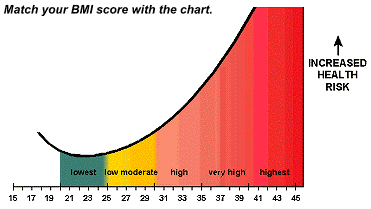|
Body Mass Index (BMI) |
|
.gif)
|
|
|
|
Body Mass Index (BMI) measures weight in relation to
height. The ranges shown are for adults and should not be used for
children.
To determine your BMI, simply enter your height and
weight where specified below. The calculator will automatically
calculate your BMI score. |
|
|
|
How to measure height and weight |
|
Height Measurement - If you are not sure how tall
you are, then follow these easy steps: |
-
Stand with your head, buttocks, and feet touching
a vertical wall. If this is not possible due to large amounts of
body fat, simply stand erect, with hands relaxed at your sides.
-
Look forward and keep your head straight and in an
upright position.
-
Straighten your spine so that your height is
maximized.
-
Have a friend gently lower a ruler down on your
head, taking care to keep it horizontal to the floor. Your friend
should then mark your height on the wall with a light pencil.
-
Use a measuring tape to determine your height.
|
|
Weight Measurement - If you have not had your weight
measured in the last month by a health care professional, follow
these easy steps to measure your weight at home: |
-
Weight should be taken first thing in the morning
on an empty stomach or two hours after your last meal.
-
Clothing should be minimal. Shoes should not be
worn.
-
Weight fluctuates day-to-day and in females
throughout the menstrual cycle. You might want to weigh yourself
for three days and use the average weight. |
|
BMI Calculator |
|
|
| NOTE: Your browser must support
Javascript for the calculator to work. |
|
|
|
BMI |
Category |
Health Risk Based Solely On BMI |
Risk Adjusted for the Presence of Co-morbid
Conditions and/or Risk Factors |
|
Below 18.5 |
Underweight |
Low |
Moderate |
|
18.5-24.9 |
Healthy Weight |
Minimal |
Low |
|
25-29.9 |
Overweight |
Moderate |
High |
|
30-34.9 |
Obese |
High |
Very High |
|
35-39.9 |
Very Obese |
Very High |
Extremely High |
|
40+ |
Morbid Obesity |
Extremely High |
Extremely
High | |
|
|
|
On the BMI table above, find your score and the
health risk for which it is assessed. For example, a BMI score of
18.5 - 25 is associated with the lowest health risk based solely on
BMI scores. If your score is 25 - 30, you are considered to be at
increased risk for health problems that are negatively impacted by
obesity, such as diabetes, heart disease, high cholesterol or
hypertension. BMI above 30 places you at higher health risks.
Exceptions to a high BMI score include competitive athletes and body
builders, whose BMI is high due to increased muscle mass, and women
who are pregnant or lactating. The BMI is also not intended for use
in measuring growing children or frail, elderly individuals.
|
|
|
 |
|
Why is BMI Important? |
|
If your BMI is high, you may have an increased risk
of developing certain diseases, including: |
-
High blood pressure
-
Heart disease
-
High blood cholesterol
-
Diabetes
-
Stroke
-
Certain types of cancer
-
Arthritis
-
Breathing problems |
|
Prevention of further weight gain is important and
weight reduction is desirable. |
|
|
|
What is a co-morbid condition or other risks
factors for chronic diseases? |
|
Co-morbidity is any condition associated with
obesity that usually worsens as the degree of obesity increases and
often improves as obesity is successfully treated. The more of the
risk factors from the following list that you have, the more likely
you are to benefit from weight loss if you are overweight or obese*:
|
-
Do you have a personal or family history of heart
disease?
-
Are you male over 45 years or a postmenopausal
female?
-
Do you smoke cigarettes?
-
Do you have a sedentary lifestyle?
-
Has your doctor told you that you have high blood
pressure, abnormal blood lipids (high cholesterol, low HDL, high
triglyceride), or diabetes? |
|
* Source: Dietary Guidelines for Americans,
2000 |
|
|
|
Improving Your Health: |
|
Weight reduction is an important way to reduce your
BMI and improve your overall health. Even a modest 5% reduction from
your current weight is beneficial to your health. For instance, a 5'
2" female who weighs 150 pounds (BMI=27), can improve her health by
losing as little as seven pounds, reducing her BMI to 26. |
|
|
|
Tipping The Scales In Your Favor: |
|
The Energy Balance Equation is the key factor in the
weight loss/weight gain puzzle. In other words - if you consistently
consume more energy (calories) than you use up, you will gain weight
and the reverse is also true, burning more energy (calories) than
you consume will cause weight reduction. It's really as simple as
that! |
|
|
|
Remember These Tips: |
-
Realistic Goals
-
The best way to lose weight and keep it off is to
balance the foods you eat with daily physical activity.
-
Eat a healthy diet and get the recommended 30
minutes or more of daily physical activity.
-
Develop healthy habits, since permanent changes
will lead to a lifetime of better health.
|
![]()